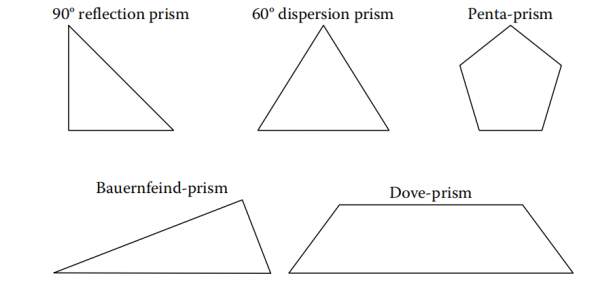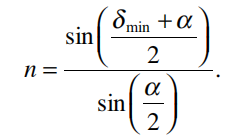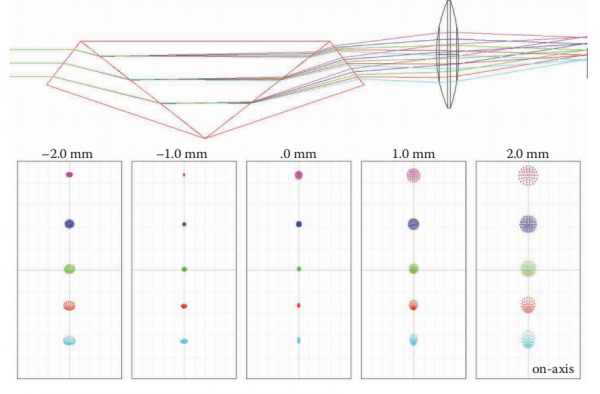What are prisms and wedges?
Prisms can be classified into three main types: deflection prisms, dispersion prisms, and polarization prisms. The denomination of prisms is usually based on geometric properties, mostly the prism wedge angle, or on the name of the inventors of a particular prism type. A selection of the most important and commonly used prisms is shown in figure below:

Deflection prism
Deflection prisms are used for the manipulation of light in terms of changing either its orientation or direction of propagation. A change in orientation is performed for image reversal, for example, as realized by Porro-prisms2 in Kepler telescopes,3 binoculars, or microscopes. Here, image reversal is due to total internal reflection within the prism.
Further, deflection prisms are employed in order to generate a deviation δ of a light beam or bundle of light rays from its original propagation direction. This deviation is given by
![]()
Here, ε1 is the angle of incidence of a light ray on the entrance surface of a deflection prism, ε 2′ is the exit angle of the light ray at the prism’s exit surface, and α is the prism wedge angle. The exit angle can be calculated according to

where ε2 is the angle of incidence of light at the interface glass-surrounding medium (e.g., air) within the prism, given by

For instance, the effect of deflection by a prism can be used for the determination of the index of refraction n of the prism material according to

Here, δmin is the minimum deviation caused by the prism, given by

which is found for the special case of so-called symmetric pass where the angle of incidence of light is equal to the exit angle.
Dispersion prism
Prisms can also be used for the segmentation of white light into its spectral fractions, i.e., wavelengths or colors, respectively.
This type of prism is referred to as dispersion prism and applied for the setup of spectrometers or for monochromatization. This is made possible by the wavelength of the index of refraction and the deviation, respectively. The dispersion angle δd (i.e., the difference in deviation δ between two considered wavelengths of interest λ1 and λ2) is given by
![]()
where λ2 < λ1 and n2 > n1, respectively.
There are a number of different types of dispersion prisms. The most common is a single prism with a prism wedge angle of 60°, made of an optical glass with a low Abbe number and a high dispersion, respectively. This prism generates both segmentation of incident white light into its spectral fractions and a general deviation of the propagation direction of light. Segmentation without such deviation is achieved by special prism assemblies, for example, Amici prisms(i.e., a prism group consisting of several cemented prisms). As shown in Figure below, the combination of such a prism group and a single lens allows setting up a simple but usable and stable spectrometer.

Polarization prism
The combination of two or more prisms also allows realizing polarization prisms, made of birefringent material such as Calcite (CaCO3); see Section 3.5. As a result, non-polarized incident light is divided up into two light rays of different polarization, s-polarized and p-polarized with a certain angular distance. This angular distance can range from some degrees to more than 90° depending on the type of polarization prism, as shown by the selection of commonly used polarization prisms listed in Table below
| wdt_ID | Polarization Prism Type | Setup | Paths of Rays | Angular Distance of Polarized Fractions |
|---|---|---|---|---|
| 1 | Nicol prism | Two cemented prisms, pointed angles 68° and 22° | Transmission of one, but reflection of the other polarization direction due to total internal reflection | ≈ 20° |
| 2 | Rochon prism, Wollaston prism | Two cemented equiangularly prisms | Transmission of both polarization directions | ≈ 15°-45° |
| 3 | Glan-Thompson prism | Two cemented equiangularly prisms | Transmission of one, but reflection of the other polarization direction due to total internal reflection | ≈ 45° |
| 4 | Glan-Foucault prism | Two prisms, pointed angles 90° and 45 °, separated by air gap | Transmission of one, but reflection of the other polarization direction at entrance interface of second prism | < 90° |
Wedges
Wedges can be referred to as deflection prisms with small wedge angles. Normally, the entrance surface is perpendicular to the incident light, and deflection of light is due to refraction at the exit surface. The wedge angle α of wedges is defined to be smaller than 10°, resulting in moderate deviation δ of incoming light according to
These optical components are thus used in order to realize slight deviations of propagation direction of light (e.g., for the compensation of lateral offsets).

